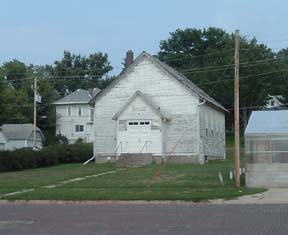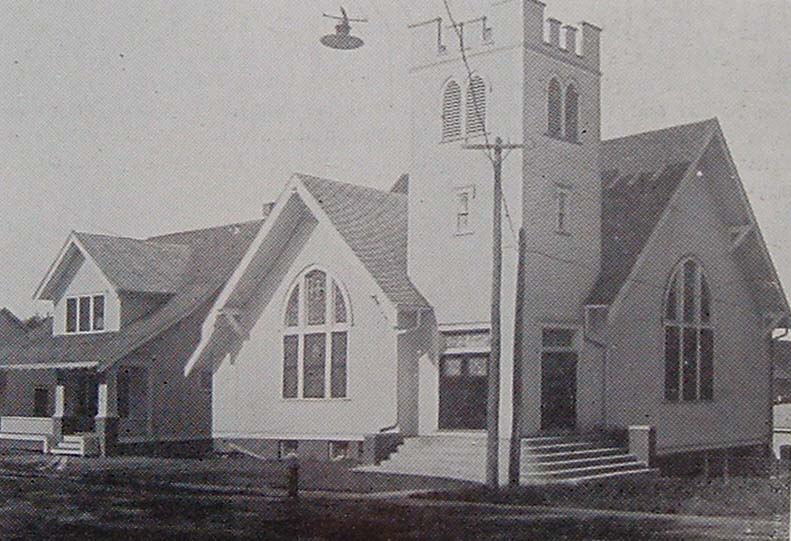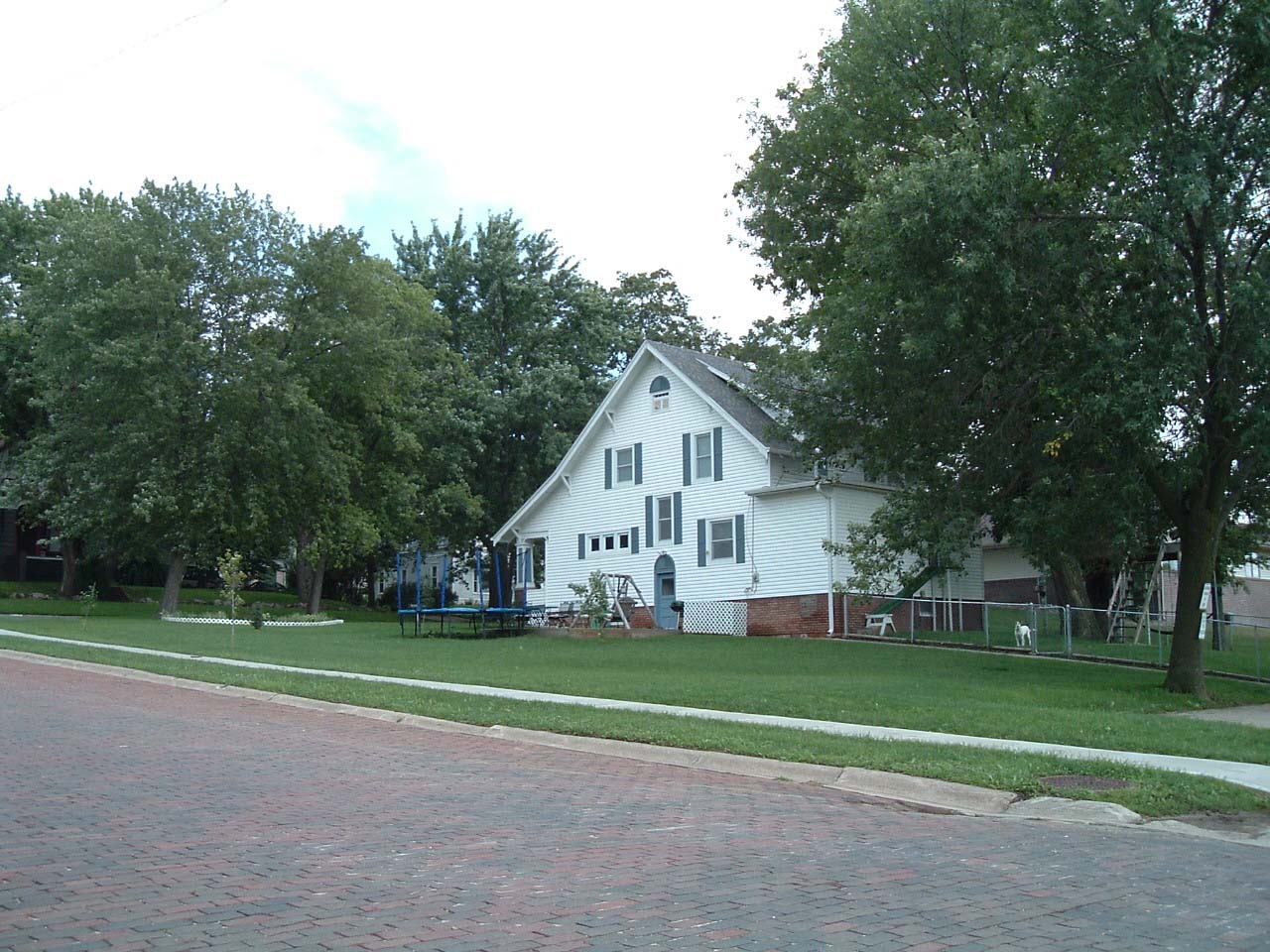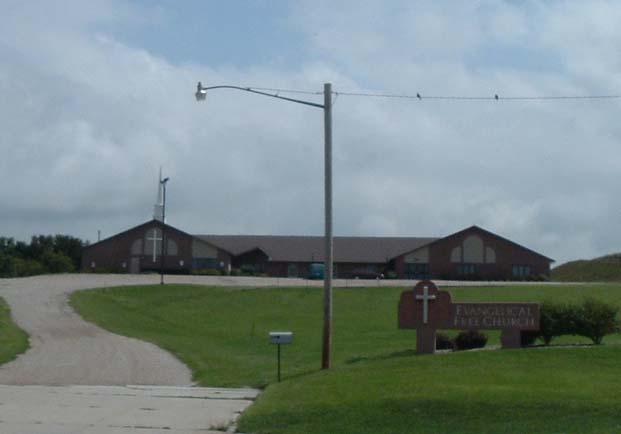The Quest for the "Mystery Church"

Oakland's "Mystery Church"

Compare with above: note four arched side windows
He also pointed out the site of the old Free church which we have seen in pictures, and said that the house now next to the vacant lot on which it stood was the parsonage...indeed is still the parsonage though the Free Church is now an expansive edifice on the edge of town.
The solution to the mystery came in comparing the picture in the "Ord och Bild" 25th anniversary book; that of the original Oakland First Covenant building with the picture of the "mystery" church. They could be one and the same. The convincing evidence lies in comparing the surviving parsonage of the 2007 picture and the Golden Jubilee Free Church picture: it appears to be the same location and the same house.

1915 Free Church: note the parsonage porch pillars

Vacant site of the 1915 Free Church with parsonage adjacent: again note pillars
Now we have the fascinating story unfolding: the Oakland Mission Covenant church outgrows its original building (occupied March 1885) and builds a new facility which now survives as the Swedish Heritage Center. For this theory to work, they would have to have done this between the writing of Ord and Bild (1912) which says nothing of a new church and 1915 when the new Free Mission Church is built. This would leave the "unused church building" which J.G. Princell visits for special meetings in 1895 with an emerging Free congregation. They then acquire the building for their own...was it the old Mission Covenant building? They also outgrow this structure and it is moved to where we find it today, and build in 1915, on the same site, the church pictured in the Free Church Golden Jubilee history and shown above!
Unfortunately for our theory it is more likely that the Princell visit and Free Church beginnings were in another location, and they only acquired the Covenant site for their second church shortly before it was built. Since the Covenant parsonage was built in 1893 the Free church would not have been at that site yet. But it does appear that the "mystery church" was the old Covenant building and that it once stood on the vacant lot pictured above next to the parsonage.

Oakland Free Church today on a spacious new location
Another question: if the parsonage next door served the Covenant pastor, where did he go when the Free acquired the church? It was a fine home built in 1893 at a cost of $8,000. We know that it is now the Free parsonage but do not know where the last Covenant parsonage was. Someone in Oakland will know...they take their history seriously.
But the lesson is learned: never overlook a structure that looks like it might once have been a church: it probably was, and probably has a story to tell.
Letter to Jerry Ronnefeldt
September, 2007
re: Mystery Church (galloping church)
Thanks so much for the page of Oakland church history!
It adds to the mystery and so to the enjoyment of sorting it out. You mention that a lady presently owns it...maybe she would let us inside?
She might also be able to shed some light on some questions that the various newspaper articles raise, namely:
Augustana historian and Oakland pastor C.F. Sandahl reports in his history that the first Augustana Lutheran church building was a 32 x 40 foot frame structure with a 70 foot steeple, one of the nicest buildings around, built in 1878. When the railroad came through, the church proved to be on "the wrong side" of the tracks and their pastor then, J. Torell, had it moved to the present location in 1880. (Sandahl also reports that Torell's father was an Oakland resident and leading layman in the congregation)
Now the newspaper writer has an "English Lutheran Church" being dedicated in 1881 with the footnote that it "at first stood in the south part of town, west of the railroad tracks, and was later moved to its present site -- that is, 300 block, Thomas Ave." I do not know if the street by the present Augustana church is Thomas Ave, but would be willing to bet that it is. If so, the evidence piles up that the "English Lutheran Church" referred to is what we would call the "Swedish Lutheran Church". Here it might be noted that in at least one case that I know of, a Scandanavian church referred to itself or was known in the community as "English" Lutheran to distinguish it from an older and better known "German" Lutheran church. Also, the English Lutheran church which was organizing in 1915 according to the story on the bottom of the page comes along much later. It does not seem possible that it could be the same group as in the opening story. But, we could also note, that the Swedish Lutheran congregation was actually started in 1868 and met in schoolhouses for a decade. And, unfortunately for our theory, none of the people mentioned in the top story appear in Sandahl's history. So it is narrowly possible that two Lutheran congregations dedicated churches in 1881 but unlikely that each had moved from "across the tracks." Perhaps it is only this point on which the editor is wrong. We know from Sandahl that the original 32x40 church burned to the ground in the early '90s and was rebuilt on the same site (by the highway) in the form in which it survives today.
The Centennial Book excerpt (I would love to see that book) agrees with everything I know. The two ladies mentioned were of the type Fredrik Franson spoke of in his book "Prophesying Daughters" and were common in the Swedish Free Church for a short time...perhaps before their time. The "unused church" remains a mystery unless more evidence turns up. It could not be the structure near the tracks we looked at because that would have been in use by the Covenant congregation at the time. The Episcopalian angle is a new one; we know of Swedish Episcopalians in Wisconsin but was this group Swedish?
Now we have to deal with Rev. Kahse and his 1915 English Lutherans. They buy our mystery church from the Frees who are about to build their new church of 1915 on the now vacant lot next to the parsonage. Here it is repeated that the group began in 1881 but "It was never in a flourishing condition. Work was given up years ago and the building sold for $600" Here we might have the "unused" church that Princell visited and in which the Frees organized. Where was it?? It is also stated that "The singular thing is that the church once before belonged to the English Lutheran congregation, and was, in fact built by that congregation. The church at first stood in the south part of town (old Oakland), west of the railroad, and was later moved to its present site."
IF THIS IS ACCURATE, we will have to concede that two churches were moved across the tracks, and that the first Covenant Church in Oakland took over an old English Lutheran building! The articles say the English dated from 1881, the Covenant we know dated from 1884. A second look at the Covenant 25th history "blue book" indicates that this WAS the case. If this is the site Thomas St. runs by, I lose my earlier bet.
The English Lutheran Church continues to present us with problems though. They bought the building from the Free and their new site is "east side of 500 block, Oakland Ave. on the corner. Later...was moved one lot north...it is now the Viking Hall" Is it now still the Viking Hall?? Or was it moved again to where our present mystery church still stands, west of Oakland Ave??
IF that is the case and IF two churches were moved "across the tracks", the mystery church presents an incredible story. It was an English Lutheran Church, then moved, then became a Covenant Church, then a Free Church, then an English Lutheran Church again, then was moved twice, and STILL survives!
Update
The writer has experienced much confusion on this question. There are some newer insights to be shared, however. The newspaper reports have to be taken seriously. The unlikely scenario that one church building belonged to three congregations (and a service club), one of them twice (!) may indeed be true. It may also be true that Princell used the building for his special meetings that chartered the Free Mission church of Oakland in spite of chronology problems. It seems doubtful that two Lutheran churches were moved across the tracks, however. That unlikely event would surely not have gone without comment in either the Lutheran history or the newspaper reports from the time. Since the English Lutheran church being moved appears as a footnote by the compiler of newspaper articles and is not contained in the accounts themselves, we remain suspicious that this is one of those assumptions we all sometimes make in error. More likely, the English Lutheran church of 1881 was always at the site now vacant adjacent the parsonage. The quest to trace these events has been a most interesting one indeed.